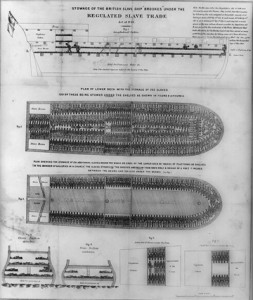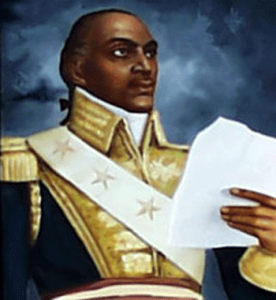In an excellent post on the history of campaigning, Max Lawson, Oxfam’s head of advocacy, reflects on what today’s campaigners on the Robin Hood Tax (or pretty much anything else) can learn from the anti-slavery movement. Cross-posted from Duncan Green’s From Poverty to Power blog.
A global industry, dominated by the UK, providing a third of our GDP. An industry that purchases politicians, and is deeply rooted in the establishment. An industry, formerly revered, now facing public condemnation for impunity and excess.
The year- not 2012, but 1780. The industry, not banking but slavery. The campaign, not for a Robin Hood Tax, but to abolish the slave trade. An amazing story of the mother of all campaigns.
Like many developing countries today, Britain in the late 18th century was a country waking up. Huge structural and economic changes were upsetting the old order. For the first time, many ordinary people could read and write. Thanks to new printing and transport technology a rash of new newspapers took just 3 days to reach Glasgow from London. News of parliament, politics and the wider world were accessible for the first time. Revolutions in France and America were seeing the birth of human rights. The anti-slavery campaign was at the heart of these changes, a product of this ferment, but also purposefully using these changes to advance its cause. Started by a small group of Quakers (as indeed was Oxfam) in a room above a printing shop in the heart of the City of London, the campaign at its peak submitted 519 petitions from around the country signed by 400,000 people. In cities like Manchester an incredible one in three people signed the petition- ordinary people, often with very tough lives themselves, taking a stand.
The abolitionists seem to have invented every modern campaign technique. There were no photographs of the horrors of slavery, so they printed hundreds of copies of the now infamous diagram (below) of the slave ship and its human cargo and distributed them in public places all over Britain.  They had Josiah Wedgewood design a broach with the immortal phrase, ‘Am I not a Man and a Brother?’, which no fashionable lady could be seen without.
They had Josiah Wedgewood design a broach with the immortal phrase, ‘Am I not a Man and a Brother?’, which no fashionable lady could be seen without.
The campaign crossed classes, from aristocrats to mill workers. They started the first boycott, even before Ireland and Captain Charles Boycott had given us the word. Half a million people gave up sugar in their tea, so as not to partake of ‘that blood-sweetened beverage’. The demand for ‘fair trade’ sugar from India rapidly increased. They had an insider strategy, with Wilberforce their champion in Parliament, complemented by an outsider strategy of unprecedented public outcry. They were attacked by well-resourced lobbyists who predicted the instant destruction of the British economy with a zeal the British Bankers’ Association would envy.
The cast of characters is riveting. Olaudah Equiano, the freed slave, whose book about his experiences was read by tens of thousands as he toured the country. He was kidnapped and returned to slavery, only to escape. Thomas Clarkson, the leader of the campaign, who travelled tens of thousands of miles on horseback for 50 years collecting evidence of the trade and encouraging support. In cities like Bristol that were dominated by slave money he was almost killed on more than one occasion. Elizabeth Heyrick, whose call for ‘immediate, not gradual abolition’ brought renewed fire and radicalism to the campaign in the final years.
They suffered many setbacks and reversals. The task they faced was huge. Slavery and the money made from it underpinned huge parts of the UK economy. Even the Church of England owned a number of slave estates. Slavery was as normal as eating meat today. The government crackdown on radicalism and Jacobinism that followed the French Revolution and the patriotic fervour of the Napoleonic war set the campaign back ten years. From the first meeting of the committee to the abolition of the slave trade took twenty years. Full abolition took a further thirty.
At a time when only one in ten men could vote, actions like petitions and boycotts allowed ordinary people, particularly women, to show support for abolition. Women were at the forefront of the campaign throughout, and were consistently more radical than the men. The majority of the slaves in the field were women too, worked to death, and unable to have children due to the brutality of their treatment. This was genocide – of over 2 million slaves shipped to the West Indies, at the time of abolition only 670,000 remained.
But this story is not just about indefatigable and remorseless campaigners. It is mainly a story of extraordinary bravery by the slaves themselves who, faced by unimaginable cruelty, rose up against their oppressors. To punish revolts, slaves were slowly burnt alive from the feet up, a practice not seen since the middle ages. In the case of Haiti, the victorious rebellion led by Toussaint L’Ouverture (right) created a Vietnam –style war that bankrupted France and led to the deaths of 45,000 of the 89,000 strong  British Army in the West Indies, dragged into the archetypal unwinnable war. In many ways Haiti is still paying for that defiance. Haiti’s revolution more than anything hastened the end of slavery, as it hit at the economic heart of the sugar industry, which in size and influence was very similar to that of oil today.
British Army in the West Indies, dragged into the archetypal unwinnable war. In many ways Haiti is still paying for that defiance. Haiti’s revolution more than anything hastened the end of slavery, as it hit at the economic heart of the sugar industry, which in size and influence was very similar to that of oil today.
The parallels with our main export, investment banking, tax avoidance and harmful financial alchemy are unavoidable. But political leadership is far less in evidence today. Whereas David Cameron is prepared to break with the EU to defend the financial services industry, William Pitt took a more radical view in favour of abolishing the slave trade:
‘How Sir! Is this enormous evil ever to be eradicated, if every nation is thus prudentially to wait until the concurrence of all the world have been obtained?….There is no nation in Europe that has, on the one hand, plunged so deeply into this guilt as Great Britain, or that is so likely, on the other, to be looked up to as an example’.
Has that loss of vision, courage and radicalism also afflicted NGOs? When I first started at Oxfam ten years ago, I was privy to a tense debate between two of my bosses over campaign strategy. Green about the ears I kept very quiet in the corner as they hammered it out. In the end one said to the other with disdain- ‘the trouble is, X, if this were the campaign against slavery you would have Oxfam campaigning for more comfortable boats’.
I think we have come a long way since then, not least in taking on the might of the financial sector in fighting for a Robin Hood Tax. But we must constantly ask ourselves whether we are living up to the radicalism and moral memory of those amazing abolitionists.
(This blog was inspired by rereading ‘Bury the Chains’ by Adam Hothschild, which should be essential reading for all those campaigning for social justice. His book about the systematic pillage of the Congo by Belgium, ‘King Leopold’s Ghost’ is also brilliant.)
